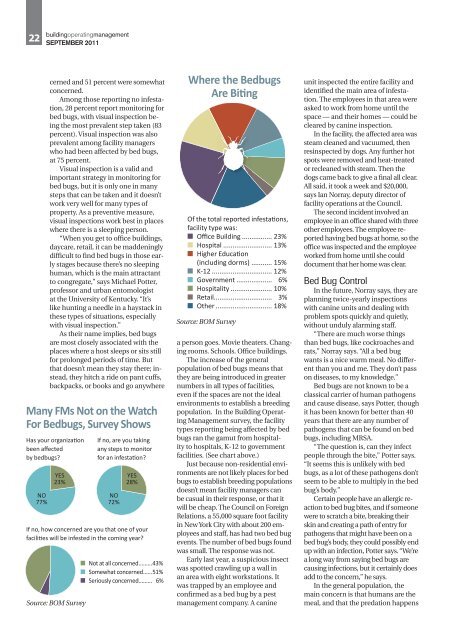Building Operating Management September 2011 - FacilitiesNet
Building Operating Management September 2011 - FacilitiesNet
Building Operating Management September 2011 - FacilitiesNet
Create successful ePaper yourself
Turn your PDF publications into a flip-book with our unique Google optimized e-Paper software.
22<br />
buildingoperatingmanagement<br />
SEPTEMBER <strong>2011</strong><br />
cerned and 51 percent were somewhat<br />
concerned.<br />
Among those reporting no infestation,<br />
28 percent report monitoring for<br />
bed bugs, with visual inspection being<br />
the most prevalent step taken (83<br />
percent). Visual inspection was also<br />
prevalent among facility managers<br />
who had been affected by bed bugs,<br />
at 75 percent.<br />
Visual inspection is a valid and<br />
important strategy in monitoring for<br />
bed bugs, but it is only one in many<br />
steps that can be taken and it doesn’t<br />
work very well for many types of<br />
property. As a preventive measure,<br />
visual inspections work best in places<br />
where there is a sleeping person.<br />
“When you get to office buildings,<br />
daycare, retail, it can be maddeningly<br />
difficult to find bed bugs in those early<br />
stages because there’s no sleeping<br />
human, which is the main attractant<br />
to congregate,” says Michael Potter,<br />
professor and urban entomologist<br />
at the University of Kentucky. “It’s<br />
like hunting a needle in a haystack in<br />
these types of situations, especially<br />
with visual inspection.”<br />
As their name implies, bed bugs<br />
are most closely associated with the<br />
places where a host sleeps or sits still<br />
for prolonged periods of time. But<br />
that doesn’t mean they stay there; instead,<br />
they hitch a ride on pant cuffs,<br />
backpacks, or books and go anywhere<br />
Many FMs Not on the Watch<br />
For Bedbugs, Survey Shows<br />
Has your organization<br />
been affected<br />
by bedbugs?<br />
NO<br />
77%<br />
YES<br />
23%<br />
NO<br />
72%<br />
YES<br />
28%<br />
If no, how concerned are you that one of your<br />
facilities will be infested in the coming year?<br />
Source: BOM Survey<br />
If no, are you taking<br />
any steps to monitor<br />
for an infestation?<br />
■ Not at all concerned .........43%<br />
■ Somewhat concerned ......51%<br />
■ Seriously concerned ......... 6%<br />
Where the Bedbugs<br />
Are Biting<br />
Of the total reported infestations,<br />
facility type was:<br />
■ Office <strong>Building</strong> ................ 23%<br />
■ Hospital .......................... 13%<br />
■ Higher Education<br />
(including dorms) ........... 15%<br />
■ K-12 ................................ 12%<br />
■ Government ................... 6%<br />
■ Hospitality ...................... 10%<br />
■ Retail............................... 3%<br />
■ Other .............................. 18%<br />
Source: BOM Survey<br />
a person goes. Movie theaters. Changing<br />
rooms. Schools. Office buildings.<br />
The increase of the general<br />
population of bed bugs means that<br />
they are being introduced in greater<br />
numbers in all types of facilities,<br />
even if the spaces are not the ideal<br />
environments to establish a breeding<br />
population. In the <strong>Building</strong> <strong>Operating</strong><br />
<strong>Management</strong> survey, the facility<br />
types reporting being affected by bed<br />
bugs ran the gamut from hospitality<br />
to hospitals, K-12 to government<br />
facilities. (See chart above.)<br />
Just because non-residential environments<br />
are not likely places for bed<br />
bugs to establish breeding populations<br />
doesn’t mean facility managers can<br />
be casual in their response, or that it<br />
will be cheap. The Council on Foreign<br />
Relations, a 55,000 square foot facility<br />
in New York City with about 200 employees<br />
and staff, has had two bed bug<br />
events. The number of bed bugs found<br />
was small. The response was not.<br />
Early last year, a suspicious insect<br />
was spotted crawling up a wall in<br />
an area with eight workstations. It<br />
was trapped by an employee and<br />
confirmed as a bed bug by a pest<br />
management company. A canine<br />
unit inspected the entire facility and<br />
identified the main area of infestation.<br />
The employees in that area were<br />
asked to work from home until the<br />
space — and their homes — could be<br />
cleared by canine inspection.<br />
In the facility, the affected area was<br />
steam cleaned and vacuumed, then<br />
resinspected by dogs. Any further hot<br />
spots were removed and heat-treated<br />
or recleaned with steam. Then the<br />
dogs came back to give a final all clear.<br />
All said, it took a week and $20,000,<br />
says Ian Norray, deputy director of<br />
facility operations at the Council.<br />
The second incident involved an<br />
employee in an office shared with three<br />
other employees. The employee reported<br />
having bed bugs at home, so the<br />
office was inspected and the employee<br />
worked from home until she could<br />
document that her home was clear.<br />
Bed Bug Control<br />
In the future, Norray says, they are<br />
planning twice-yearly inspections<br />
with canine units and dealing with<br />
problem spots quickly and quietly,<br />
without unduly alarming staff.<br />
“There are much worse things<br />
than bed bugs, like cockroaches and<br />
rats,” Norray says. “All a bed bug<br />
wants is a nice warm meal. No different<br />
than you and me. They don’t pass<br />
on diseases, to my knowledge.”<br />
Bed bugs are not known to be a<br />
classical carrier of human pathogens<br />
and cause disease, says Potter, though<br />
it has been known for better than 40<br />
years that there are any number of<br />
pathogens that can be found on bed<br />
bugs, including MRSA.<br />
“The question is, can they infect<br />
people through the bite,” Potter says.<br />
“It seems this is unlikely with bed<br />
bugs, as a lot of these pathogens don’t<br />
seem to be able to multiply in the bed<br />
bug’s body.”<br />
Certain people have an allergic reaction<br />
to bed bug bites, and if someone<br />
were to scratch a bite, breaking their<br />
skin and creating a path of entry for<br />
pathogens that might have been on a<br />
bed bug’s body, they could possibly end<br />
up with an infection, Potter says. “We’re<br />
a long way from saying bed bugs are<br />
causing infections, but it certainly does<br />
add to the concern,” he says.<br />
In the general population, the<br />
main concern is that humans are the<br />
meal, and that the predation happens





